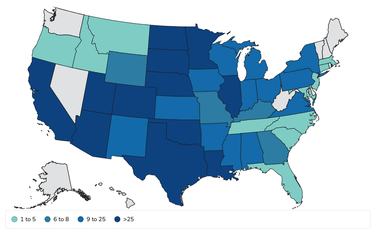West Nile virus case confirmed in Albany County
ALBANY COUNTY — For the first time since 2018, a resident of Albany County has a confirmed case of West Nile virus, according to a Sept. 18 release from the county’s health department.
The disease is spread by the bite of a mosquito infected with the virus after feeding on infected birds.
In humans, West Nile virus may cause a mild illness but may also cause encephalitis or meningitis.
The disease, which is native to New York, is generally found in at least part of the state each summer.
There is no vaccine or treatment for the disease in humans. Health care providers diagnose the disease based on symptoms and by testing blood or spinal fluids, which will show if the virus or antibodies against the virus are present.
Only female mosquitoes have the needle-shaped proboscis needed to puncture skin and draw blood, which is necessary for producing eggs. Male mosquitos subsist on nectar.
Historically, from 1999 to 2023, according to the CDC, Albany County has had an incidence of 0.03 per 100,000 of population for West Nile virus human neuroinvasive disease.
This year, the CDC reports, as of Sept. 16, six cases in New York City, another six on Long Island, two in Westchester County, three in Onondaga County, and four in Erie County.
Nationwide, the most cases — nearly 10,000 — were reported in 2003. Another spike, of close to 6,000 cases, occurred in 2012; reported cases have been under 3,000 annually since then.
About one in five people who are infected develop a fever with other symptoms such as headache, body aches, joint pains, vomiting, diarrhea, or rash. Most people with an elevated body temperature due to West Nile virus recover completely, but fatigue and weakness can last for weeks or months.
About one in 150 people who are infected with West Nile virus develop a severe illness affecting the central nervous system such as encephalitis or meningitis.
Symptoms of severe illness include high fever, headache, neck stiffness, stupor, disorientation, coma, tremors, convulsions, muscle weakness, vision loss, numbness and paralysis. Recovery can take several weeks or months and some effects might be permanent.
About one out of 10 people who develop severe illness affecting the central nervous system die.
“The recent case of West Nile Virus in our community is a timely reminder that prevention of mosquito bites is the best protection against West Nile Virus and other mosquito-borne illnesses,” said the county’s health commissioner, Kristen A. Navarette, in the release.
“By following the Fight the Bite steps, including using insect repellant, wearing long sleeves and pants, and removing standing water around our homes, we can safely get outside and enjoy the beautiful weather we’re having while still keeping ourselves and our families healthy,” she said.
August through September is peak activity season for mosquitos, and they will remain active until the first or second hard frost, when the populations are reduced.
County health officials encourage residents to protect themselves when outdoors by using an effective mosquito repellent and wearing long pants and long sleeves, especially during dawn and dusk when mosquito activity is greatest.
Additionally, residents can reduce the mosquito population around their home by eliminating standing water sources. This includes disposing of used tires, tin cans, plastic containers, ceramic pots, or similar water-holding items.


